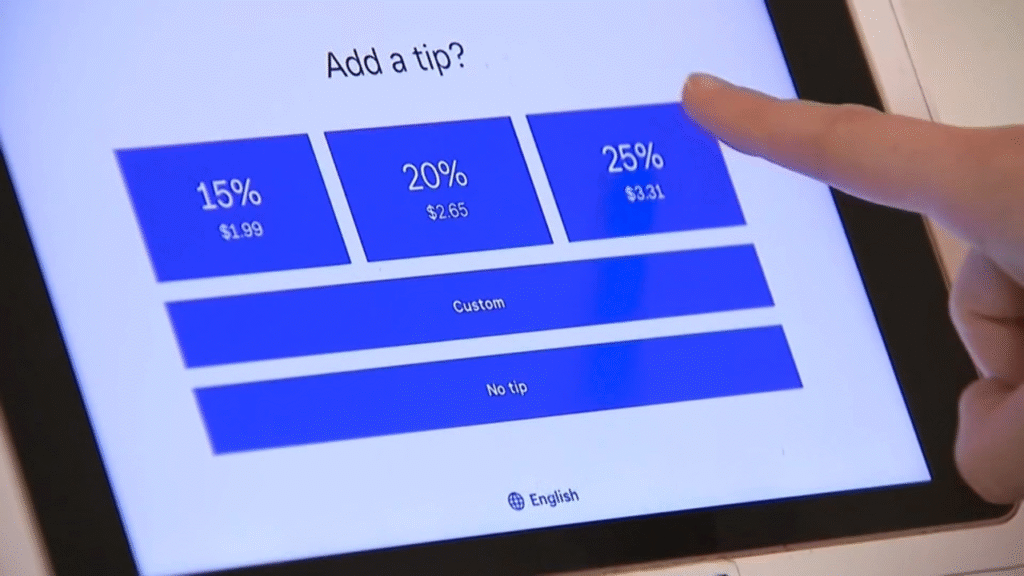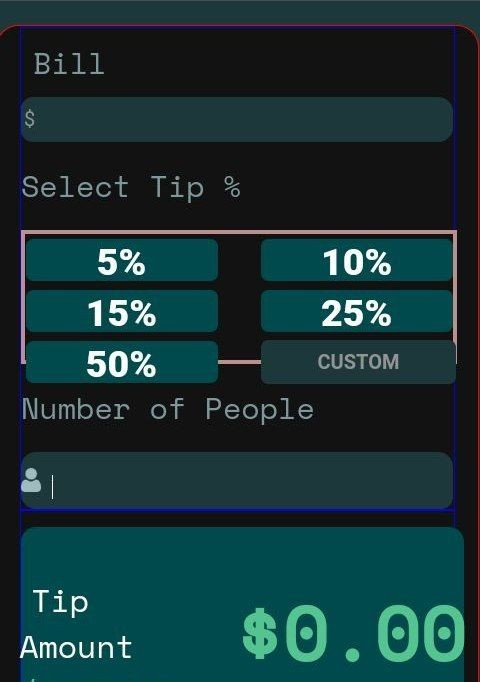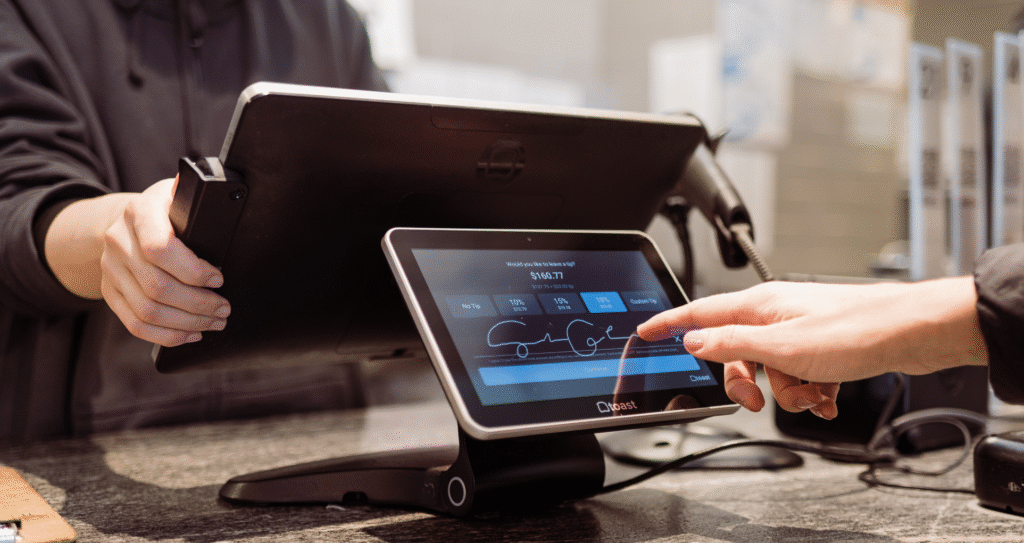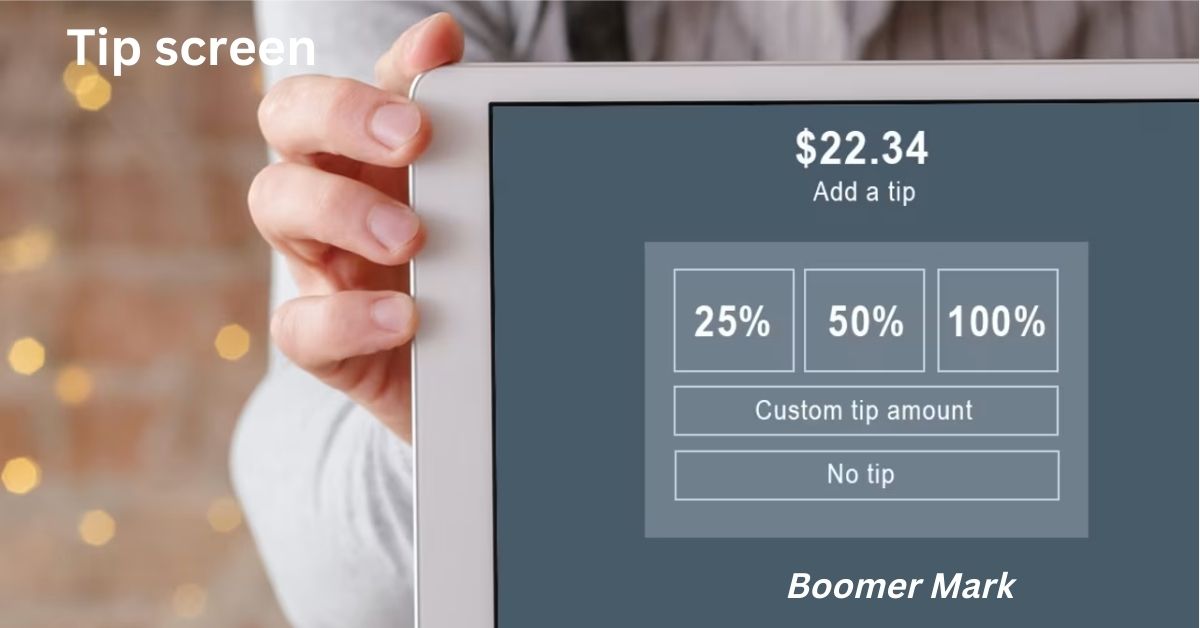What Is a Tip Screen?
A tip screen is a digital interface, usually found on touchscreen devices such as tablets, point-of-sale systems (POS), or kiosks, that prompts users to leave a tip after completing a purchase or service. Tip screens are now commonly seen in coffee shops, salons, food trucks, rideshares, and delivery apps. This screen typically appears after the payment is processed, offering pre-set tip options like 10%, 15%, or 20%, as well as a custom amount.
How the Tip Screen Changed the Way We Tip
The tip screen has completely changed how people tip. In the past, tipping was often done in cash and mostly in restaurants. Now, with digital payments becoming standard, tip screens are showing up everywhere—from local bakeries to mobile apps. This shift makes it easier for customers to tip, but also puts some pressure on them due to the public display of tipping choices. The tip screen technology has created a new kind of social expectation, where customers might feel obligated to tip more than they would have before.

Why Tip Screen Technology Is Becoming Popular Worldwide
Tip screen technology is growing fast across the globe. Businesses love it because it boosts their tips and makes the payment process smoother. Customers like it because it saves time and helps them avoid doing mental math. The use of tip screens also reduces the need for physical money, which is helpful in a world that is going more digital every year.
Also Read:Increditools: The Ultimate Resource for Software Coupons and Product Reviews
Benefits of Using a Tip Screen for Businesses
Businesses that use tip screens often see higher tip amounts. Since the tipping options are clearly displayed on the screen, customers are more likely to select one of the pre-set amounts. This means better earnings for service staff. Another benefit is faster transactions. The customer just taps a button, and the process is done. No need to fumble for cash or coins. Lastly, using a tip screen shows customers that the business is modern and tech-savvy, which can leave a good impression.
How Customers Feel About the Tip Screen Experience
Some customers find the tip screen convenient, while others feel pressured by it. Since the screen often shows tipping suggestions before they can finish the payment, they may feel forced to leave a tip, especially when others are watching. Still, many users appreciate the ease of not having to calculate tips themselves. The clear design and one-tap options make the process simple and quick.
The Role of the Tip Screen in Service Industry Growth
In service industries like hospitality, delivery, and grooming, the tip screen is becoming a vital tool. Employees in these industries often rely on tips as a large part of their income. By offering a digital and easy way to tip, businesses help workers earn more. Also, customers tend to give more when the tip screen suggests a default rate. This boosts overall satisfaction, both for the customer and the employee.
Types of Devices That Use Tip Screen Technology
Tip screen interfaces are used in various devices. POS systems like Square, Clover, and Toast use built-in tip screens. Tablets mounted at cashier counters also offer tip prompts. Self-checkout machines and mobile payment apps such as Uber Eats, DoorDash, and Instacart include tip screens at the end of the transaction. These screens often display percentages or dollar amounts and sometimes show the tip history or average tip amount to guide the customer.
Also Read:Winqizmorzqux Product: The Ultimate Everyday Tool for Simplicity and Innovation
The Psychology Behind Tip Screen Choices
Many people don’t realize that the way tip options are displayed can affect how much they tip. This is called choice architecture. If the tip screen shows 15%, 20%, and 25% as the only options, people are likely to choose one of them. If the lowest choice is 18%, the average tip amount increases. By designing tip screens in this way, businesses can encourage higher tips without saying a word. This practice is becoming common, and customers are learning to notice it.
Using a Smart Tip Screen Calculator
A smart tip screen calculator helps users figure out the right tip amount depending on their situation. This tool takes into account the total bill, service quality, country or region, and even whether the tip is shared among staff. These calculators are now available online and in mobile apps. They are especially helpful for travelers who are unsure how much to tip in a foreign country or culture.

Tip Screen Etiquette: What You Should Know
Tipping through a tip screen is different from leaving cash on a table. Many people wonder if they need to tip every time a screen pops up. The truth is, not all services require a tip. In places like self-serve coffee shops or food pick-up counters, tipping is optional. But for full-service interactions—such as getting a haircut, a massage, or a ride—it’s considered polite to leave a tip. It’s important to tip based on the quality of the service, not just because the screen suggests it.
Tip Screen Around the World: Cultural Differences in Tipping
Tipping habits vary by country. In the United States, tipping is expected in most service situations, and tip screens reflect that. But in countries like Japan and South Korea, tipping is rare and can even be seen as rude. In Europe, some countries include service charges in the bill, so customers don’t need to tip unless they really want to. The rise of the tip screen has brought some confusion in international settings, so knowing the local customs helps.
Are Tip Screens Always Fair to Workers?
Tip screen systems can be very helpful for workers, but they are not perfect. In some cases, tips go to the business and not directly to the employees. Some companies pool the tips and divide them among the staff, which can feel unfair to those who worked harder or longer. It’s important for businesses to be transparent about where the tips go. If a tip screen is used honestly, it can improve worker pay and satisfaction. But when it’s not, it can cause problems.
Also Read:Kingxomiz: The Fantasy Identity Changing How We Imagine, Create, and Connect
How to Avoid Tipping Pressure on Tip Screens
If you feel uncomfortable when a tip screen appears, remember that tipping is usually optional. You can always choose “No tip” or enter a custom amount. If you’re unsure about whether to tip, think about how much effort the person gave and whether the service made your day better. You don’t have to follow what the screen shows. Tip screens should help you, not force you.
Future Trends in Tip Screen Technology
In the future, tip screens may become even smarter. Some developers are working on systems that adjust tipping suggestions based on customer habits. Others are adding features like facial recognition, AI feedback, and loyalty rewards. For example, you might earn a small reward or points every time you tip a certain amount. These features are designed to make tipping more engaging and personal. Voice-activated tip screens and contactless tip methods are also being tested in many countries.
Tip Screen vs. Traditional Tipping Methods
Compared to traditional tipping, the tip screen is quicker, more consistent, and easy to track. With cash tips, businesses often have trouble keeping records. With a tip screen, everything is stored digitally. It also helps workers prove their income when applying for loans or housing. Still, some people prefer cash because it feels more personal. Whether you choose the old or new way depends on your comfort and the situation.

Best Practices for Businesses Using a Tip Screen
Businesses should follow best practices when installing a tip screen. They should avoid aggressive prompts that make customers uncomfortable. Tip suggestions should be fair and flexible. For example, offering 10%, 15%, and 20% is better than only showing 18%, 20%, and 25%. Clear language and optional fields make customers more likely to tip. Training staff to explain the tip screen helps too.
Also Read:LessInvest.com Real Estate: Your Step-by-Step Guide to Smarter Property Investment
How to Set Up a Tip Screen for Your Business
If you want to set up a tip screen, you’ll need a POS system that supports it. Popular choices include Square, Toast, and Shopify. You can customize the screen to show tip percentages, dollar amounts, or even emojis. Some systems allow tipping by scanning a QR code on the customer’s phone. Setup usually takes less than an hour, and many services offer tutorials.
FAQs About Tip Screen
What is a tip screen used for?
A tip screen is used to suggest and process tips after a customer makes a purchase or receives a service.
Do I have to tip if a tip screen pops up?
No, tipping is optional. You can skip it or choose a custom amount depending on your experience.
Are tip screens legal?
Yes, tip screens are legal, but businesses must follow local laws about tipping, service charges, and transparency.
Can businesses see what tip I left on the screen?
Yes, businesses can see tips, but the data is usually used for accounting, not to judge you.
Do employees always receive the tip from the screen?
Not always. Some tips go to the business or are shared among staff. It depends on the business’s policy.
Can I trust a smart tip screen calculator?
Yes, smart tip screen calculators use real-time data and logic to give fair and helpful tip suggestions.
Conclusion
The tip screen has revolutionized how people give and receive tips in today’s digital world. It makes the process easier, faster, and often more generous. While it comes with challenges like social pressure and fairness concerns, tip screens are likely here to stay. As long as both businesses and customers use them respectfully, this technology can continue to improve the tipping experience for everyone.
